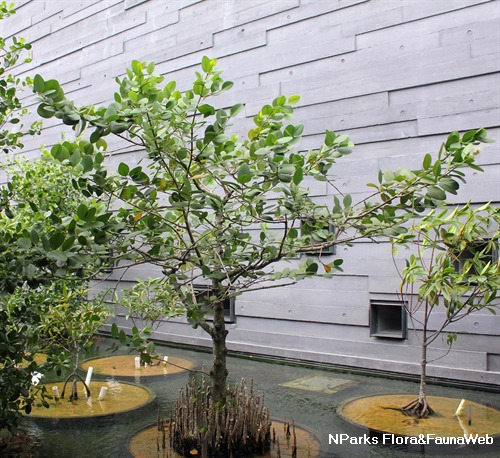
Back
Sonneratia alba Sm.
| Family Name: | Lythraceae |
| Synonyms: | Sonneratia acida Benth., Sonneratia griffithii |
| Common Name: | Perepat, Mangrove Apple, Pedada, Pidada, 杯萼海桑 |
Name
Classifications and Characteristics
| Plant Division | Angiosperms (Flowering Seed Plants) (Dicotyledon) |
|---|---|
| Plant Growth Form | Tree (Medium (16m-30m)) |
| Lifespan (in Singapore) | Perennial |
| Mode of Nutrition | Autotrophic |
| Plant Shape | Broad / Mushroom / Hemispherical, Shrubby |
| Maximum Height | 30 m |
Biogeography
| Native Distribution | From East Africa to India, Bangladesh, throughout Southeast Asia (including Singapore), south China, to New Guinea, Australia and West Pacific. |
|---|---|
| Native Habitat | Shoreline (Mangrove Forest, Sandy Beach, Rocky Beach, Mudflat) |
| Preferred Climate Zone | Tropical |
| Local Conservation Status | Native to Singapore (Least Concern (LC)) |
Description and Ethnobotany
| Growth Form | It is a tree, with a broad, spreading canopy, usually 15 - 20 m tall, and sometimes up to 30 m tall. |
|---|---|
| Trunk | Cream-coloured to brown bark, with smooth, fine, longitudinal fissures. |
| Roots | It bears thick and blunt pneumatophores (conical roots that emerge vertically from the ground) that are up to 1 m tall. |
| Foliage | Its stalked, opposite leaves are elliptic to ovate or obovate in shape, with a rounded or broad leaf tip, 5-11 cm long and 4-8 cm wide. Leaf stalks are 6 - 15 mm long and has vestigial glands at the base. |
| Flowers | Its white petaled flowers bear numerous white stamens which give it a powder-puff like appearance. The white stamens are soon shed after blooming. Petals measure about 13 - 20 by 0.5 - 1.5 mm. The flowers are borne in clusters of 5-8, and only bloom at night. |
| Fruit | Its fruits are hard, fleshy berries that are round and flattened, with a persistent calyx at the base, 2-4.5 cm across, ripening green. |
| Habitat | It grows in tropical coasts, in mangrove forests, sandy beaches and mudflats. It occurs locally in all mangrove forests in Singapore. Pioneering species in the mangrove habitat, intolerant of long periods of exposure to fresh water. |
| Associated Fauna | Its flowers are pollinated by bats at night. |
| Cultivation | It can be propagated by seed. |
| Etymology | Latin, Sonneratia, after Pierre Sonnerat (1749–1841), French botanist and explorer; Latin; alba, white, referring to the white petals and stamens of the flowers. |
| Ethnobotanical Uses | Edible Plant Parts : Edible Fruits Timber & Products: Wood is used for constructing houses, boats, flooring, bridges, wharves, furnitures and musical instruments. Cultural / Religious: Heritage Tree : There are currently two individuals of Sonneratia alba listed as Heritage Trees in Singapore. Both can be found on Pulau Ubin. To find out more about these trees, please visit the Heritage Tree Register. |
Plant Care and Propagation
| Light Preference | Full Sun |
|---|---|
| Water Preference | Lots of Water |
| Plant Growth Rate | Moderate |
Image Repository
Others
| Master ID | 30430 |
|---|---|
| Species ID | 4739 |
| Flora Disclaimer | The information in this website has been compiled from reliable sources, such as reference works on medicinal plants. It is not a substitute for medical advice or treatment and NParks does not purport to provide any medical advice. Readers should always consult his/her physician before using or consuming a plant for medicinal purposes. |







.jpg)
.jpg)
.jpg)

-(27).jpg)